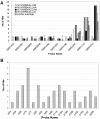BAC library resources for map-based cloning and physical map construction in barley (Hordeum vulgare L.)
- PMID: 21595870
- PMCID: PMC3224359
- DOI: 10.1186/1471-2164-12-247
BAC library resources for map-based cloning and physical map construction in barley (Hordeum vulgare L.)
Abstract
Background: Although second generation sequencing (2GS) technologies allow re-sequencing of previously gold-standard-sequenced genomes, whole genome shotgun sequencing and de novo assembly of large and complex eukaryotic genomes is still difficult. Availability of a genome-wide physical map is therefore still a prerequisite for whole genome sequencing for genomes like barley. To start such an endeavor, large insert genomic libraries, i.e. Bacterial Artificial Chromosome (BAC) libraries, which are unbiased and representing deep haploid genome coverage, need to be ready in place.
Result: Five new BAC libraries were constructed for barley (Hordeum vulgare L.) cultivar Morex. These libraries were constructed in different cloning sites (HindIII, EcoRI, MboI and BstXI) of the respective vectors. In order to enhance unbiased genome representation and to minimize the number of gaps between BAC contigs, which are often due to uneven distribution of restriction sites, a mechanically sheared library was also generated. The new BAC libraries were fully characterized in depth by scrutinizing the major quality parameters such as average insert size, degree of contamination (plate wide, neighboring, and chloroplast), empty wells and off-scale clones (clones with <30 or >250 fragments). Additionally a set of gene-based probes were hybridized to high density BAC filters and showed that genome coverage of each library is between 2.4 and 6.6 X.
Conclusion: BAC libraries representing >20 haploid genomes are available as a new resource to the barley research community. Systematic utilization of these libraries in high-throughput BAC fingerprinting should allow developing a genome-wide physical map for the barley genome, which will be instrumental for map-based gene isolation and genome sequencing.
Figures




Similar articles
-
Generation of a BAC-based physical map of the melon genome.BMC Genomics. 2010 May 28;11:339. doi: 10.1186/1471-2164-11-339. BMC Genomics. 2010. PMID: 20509895 Free PMC article.
-
Construction and characterization of a soybean bacterial artificial chromosome library and use of multiple complementary libraries for genome physical mapping.Theor Appl Genet. 2004 Sep;109(5):1041-50. doi: 10.1007/s00122-004-1712-y. Epub 2004 May 26. Theor Appl Genet. 2004. PMID: 15164176
-
Physical mapping of a large plant genome using global high-information-content-fingerprinting: the distal region of the wheat ancestor Aegilops tauschii chromosome 3DS.BMC Genomics. 2010 Jun 17;11:382. doi: 10.1186/1471-2164-11-382. BMC Genomics. 2010. PMID: 20553621 Free PMC article.
-
History and future perspectives of barley genomics.DNA Res. 2020 Aug 1;27(4):dsaa023. doi: 10.1093/dnares/dsaa023. DNA Res. 2020. PMID: 32979265 Free PMC article. Review.
-
The emergence of whole genome association scans in barley.Curr Opin Plant Biol. 2009 Apr;12(2):218-22. doi: 10.1016/j.pbi.2008.12.007. Curr Opin Plant Biol. 2009. PMID: 19185530 Review.
Cited by
-
Induced mutations in circadian clock regulator Mat-a facilitated short-season adaptation and range extension in cultivated barley.Proc Natl Acad Sci U S A. 2012 Mar 13;109(11):4326-31. doi: 10.1073/pnas.1113009109. Epub 2012 Feb 27. Proc Natl Acad Sci U S A. 2012. PMID: 22371569 Free PMC article.
-
Construction and characterization of a bacterial artificial chromosome library for the hexaploid wheat line 92R137.Biomed Res Int. 2014;2014:845806. doi: 10.1155/2014/845806. Epub 2014 May 5. Biomed Res Int. 2014. PMID: 24895618 Free PMC article.
-
The barley Frost resistance-H2 locus.Funct Integr Genomics. 2014 Mar;14(1):85-100. doi: 10.1007/s10142-014-0360-9. Epub 2014 Jan 18. Funct Integr Genomics. 2014. PMID: 24442711
-
PROTEIN DISULFIDE ISOMERASE LIKE 5-1 is a susceptibility factor to plant viruses.Proc Natl Acad Sci U S A. 2014 Feb 11;111(6):2104-9. doi: 10.1073/pnas.1320362111. Epub 2014 Jan 30. Proc Natl Acad Sci U S A. 2014. PMID: 24481254 Free PMC article.
-
A Homolog of Blade-On-Petiole 1 and 2 (BOP1/2) Controls Internode Length and Homeotic Changes of the Barley Inflorescence.Plant Physiol. 2016 Jun;171(2):1113-27. doi: 10.1104/pp.16.00124. Epub 2016 Apr 14. Plant Physiol. 2016. PMID: 27208226 Free PMC article.
References
-
- Peterson DG, Tomkins JP, Frisch DA, Wing RA, Paterson AH. Construction of plant bacterial artificial chromosomes (BAC) libraries: an illustrated guide. Journal of Agricultural genomics. 2000;5
-
- Vilarinhos AD, Piffanelli P, Lagoda P, Thibivilliers S, Sabau X, Carreel F, D'Hont A. Construction and characterization of a bacterial artificial chromosome library of banana (Musa acuminata Colla) Theor Appl Genet. 2003;106(6):1102–1106. - PubMed
Publication types
MeSH terms
LinkOut - more resources
Full Text Sources

